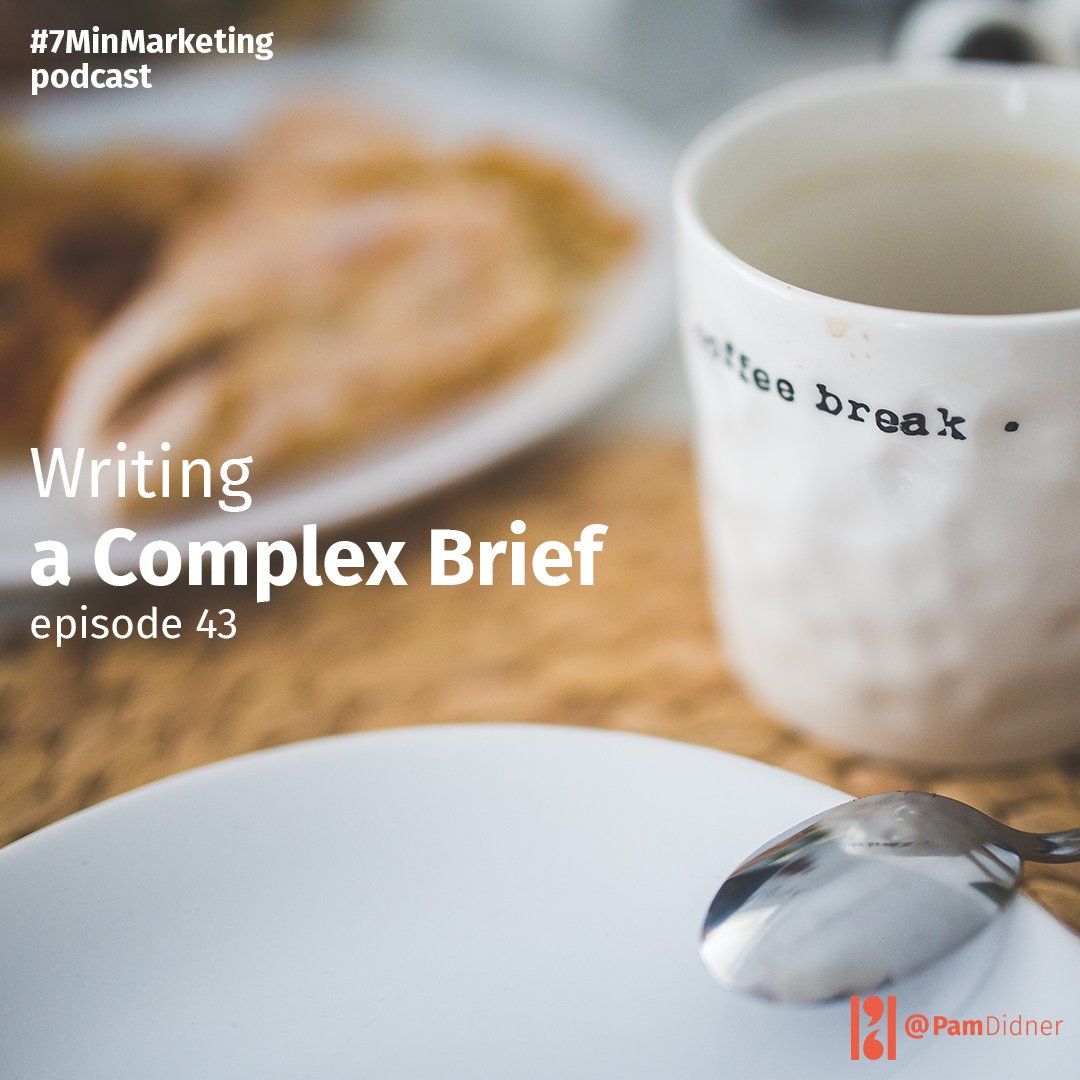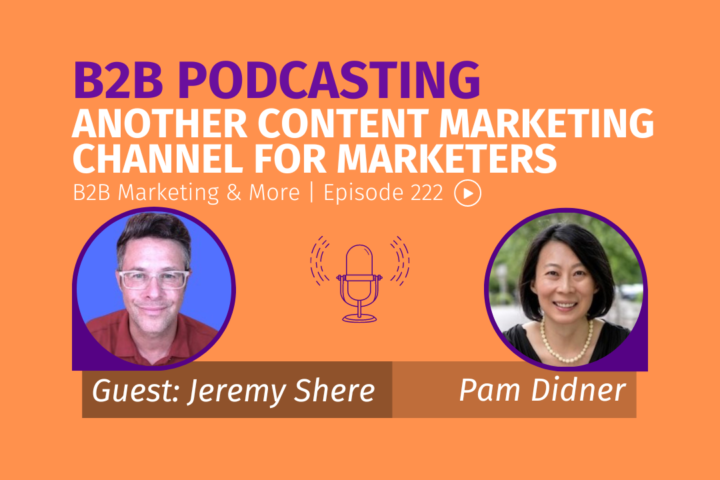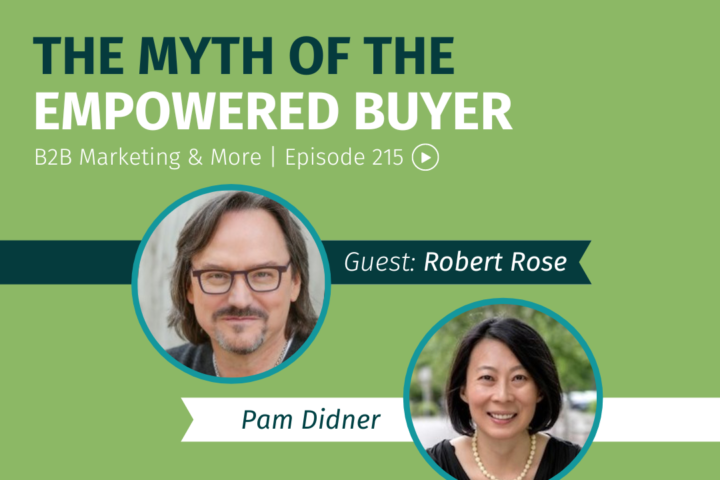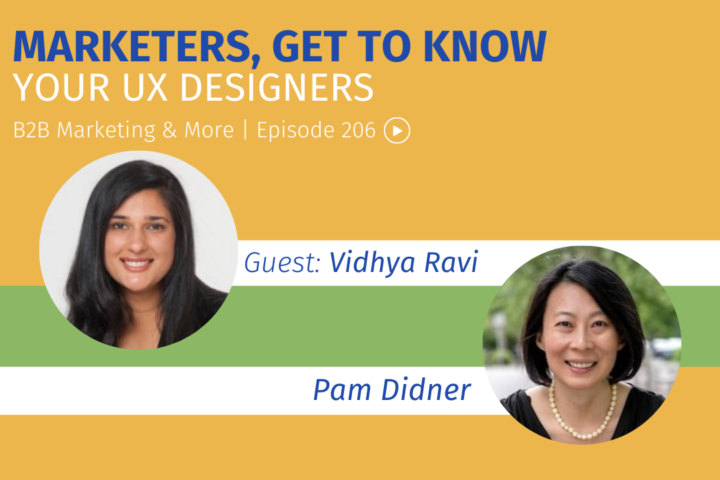
Welcome to another episode of 7-Minute Marketing with Pam. Pam Didner here. I love sharing a little dose of B2B, digital, content marketing and sales enablement, seven minutes at a time.
I spent the past 10 days writing a complicated strategic brief on behalf of an agency to brief their creative team, copywriters and content creators. This agency is running a big campaign for a large technology company.
I’ve briefed creative, media and social media teams, content marketing agencies and freelancers before. This is nothing new to me. But this time is different and it’s super-complicated.
There are 6 dimensions that I have to take into account as part of the brief:
- One very sophisticated and feature-rich technology product
- There are 4 major solution areas I can vouch for this product. Under the 4 major solution areas, there are 8 subcategories.
- We’ve identified 3 personas that we can target.
- In addition to personas, the campaigns need to cover 3 stages of the purchase cycle which are awareness, evaluation, and purchase.
- We are launching in 5 countries. It means multiple languages.
- The last element is that we do 3 separate campaigns as part of the brief.
I just mentioned 6 individual elements, but I still haven’t explained the intricacies among these elements or how they’re related to each other.
No matter how it’s sliced and diced, it’s a complicated brief.
How and where to start
So, I started from the top by clearly articulating the overall communications objectives, then moved on to campaign objectives. They are not necessarily the same. Communications objectives are what you want to accomplish overall with your marketing outreach and integration. A campaign objective is a specific instance you run for a specific period of the time which can achieve one of the communication objectives or target one or two personas. I want to make sure that everyone understands the overall communications objectives, then explain what we want to accomplish as a team by running the 3 campaigns.
That took a little time to write and I reviewed that with my contact and made sure that they agree with the objectives.
From that, I worked to describe the overall market landscape:
- The overall competitive landscape
- The Projected Total Available Market
- What are some megatrends and their impact on our products and services?
- What are the client’s offerings in the overall marketing landscape?
After researching all that, I added the current status update to my brief to help people get up-to-speed by sharing the past history. In general, I don’t add the current status update field. However, these 3 new campaigns are the extension of past campaigns.
The next step
The next is the target audience, purchase funnel, and product focus information.
After that, I incorporated marketing channels. Understanding a list of marketing channels will help content creators and the creative team determine the type of content and templates they need to create. If YouTube is one in the marketing mix, well, we need some video content. If we need to support print, then we need to create print content.
As part of the brief, I’ll add messaging and creative guidance. For brief guidance, I’ll identify either one messaging statement or one or two keywords to guide the creative exploration.
For this complicated brief, I also added a complete messaging framework based on audience’s challenges to guide the content creation process. To further help content creators, I added a narrative for each persona. The information will also further help content needs.
Oh, one thing I start to add to my briefs is the keyword list for SEO purposes.
I didn’t add the list of content that we need to assemble, but those deliverables will come later after a content audit.
The result
When I finally did the briefing meeting. It’s a FTF meeting. During that meeting, there were a lot of questions. Most focused on detailed tasks and the specifics of what they needed to do. The team talked things through on who does what. It was productive.
Most briefing sheets don’t need to have as many categories like this one. At a minimum, you need to understand your company’s overall marketing objectives, campaign objective and goals, audience, messaging and product priority. The brief sheet is usually 1-2 pages.
Of course, if you, as a client, have background information for agencies, you need to attach that. It’s better for clients to supply the information in the brief so that content creators and agencies don’t need to waste hours doing their own research and charging you for doing that.
My briefing sheets have been evolving over the past two years. I have a base template but then I add and delete categories depending on the situations we are in, the goals we want to accomplish and the available budget.
The briefing is such a challenging job. As a briefer, I need to comb through all the information, select and find the relevant information that my team needs.
Here are some tricks for creating a brief:
- Know your customers well.
- Understand how the brief will be used and know your team members’ needs.
- Have a brief meeting and allow the team to discuss and ask questions.
- Keep it simple and focused. That’s the hard part.
When I was all done, this particular, complex brief was over 5 pages. Like I said, most won’t be nearly as long. Try to keep it as short as possible while providing all the information necessary to carry out the campaigns.
Do you have a brief template you follow? Love to see how you structure your brief.
Please, send me your marketing questions and thoughts on how you provide creative brief here or via Twitter @pamdidner.
Be well. Until next time.



